The planar wars heat up, with the “Pro” successor to the legendary LETSHUOER S12 entering the ring.
When the Tin P1 were released a couple of years back, planar IEMs were still in their embryonic phase. The P1 were a proof-of-concept of what planar drivers could bring to the table; however, they were hard to drive and had anemic bass.
Thereafter, other CHI-FI planars were gingerly released, most of which flew under the table, namely, the Tin P1 Plus, Tin P2, Tin P2 Plus, Toneking P10, Toneking BL1, and TFZ Balance 7.
- Solid build
- Above average isolation
- Included cable has swappable modules for balanced and unbalanced sources
- Relatively easy to drive but scales with amplification
- Fast transients
- Above-average technical performance
- Relatively balanced V-shaped set
- Maybe a bit bright for treble-sensitive brethren
- Overly recessed midrange – may not be the best option for vocal or mid-lovers
- Potential fit issues
These planars were relegated to brief footnotes on audio forums and didn’t gain much mainstream traction. That is, until the 7Hz Timeless arrived, heralding the era of the planar IEM hype train.
The Timeless were released at the end of last year to much fanfare, generating rave reviews, as many audiophiles flocked to embrace a newfangled and exotic-turned-mainstream technology.
Indeed, the Timeless were so successful that a sequel – the 7Hz x Crinacle: Salnotes Dioko – was released to build on their success.
CHI-FI competitors subsequently caught on – like a shark smelling blood – and had a FOMO (fear of missing out). They tried to muscle in on the planar pie, releasing the LETSHUOER S12, LETSHUOER Z12, Tin P1 Max, TRN Kirin, Muse HIFI Power, Moondrop Stellaris, CCA PLA13, KZ PR1 Balanced, and KZ PR1 HIFI.
Some innovative CHI-FI companies even attempted to fuse planars with conventional drivers – the TRI I3, I3 Pro, Raptgo Hook-X, and Kinera Celest Gumiho are cases in point. Regarding the latter, there’s some controversy about whether the drivers used in the Celest could be classified as legitimate planars, but that’s a tale for another time.
To up the ante further, “tunable” planars like the DUNU Talos entered the fray. The Talos incorporate a switch to morph between different tuning configurations on-the-fly, triggering a pure planar set-up versus a planar + BA configuration.
The S12 Pro that we will be reviewing today are a special 6th-anniversary version of the well-regarded original S12 IEMs.
What’s different from the original? LETSHUOER says the Pro version have a different color, an updated nozzle filter, and a cable with swappable modules. The S12 Pro bodies are also redesigned, with added vents on the housing to reduce pressure build-up in the ears.
Company Overview
LETSHUOER was founded in 2016 by an experienced team; each member has an average of 16 years of experience in the audio arena. Their products are all designed and hand-assembled in-house.
Their product line-up includes the S12 and Z12 mentioned above and other luminaries such as the D13, EJ07, EJ07M, EJ09, Conductor, Soloist, Tape Pro, and Singer.
LETSHUOER also dabbles in cables and sources, such as the M5 and DT02, respectively.
Technical Specifications
- Form: IEMs
- Drivers: Custom 14.8mm planar magnetic driver
- Impedance (Ohm): 16 Ω
- Sensitivity (dB): 102 dB
- Frequency Response (Hz): 20 Hz – 20 kHz
- Removable Cable: Y
- Cable: High-purity 392-core mono-crystalline silver-plated copper cable
- Source Plug: Connectors with 2.5mm, 3.5mm, and 4.4mm modular terminations
- Cup/Shell Plug: 2-pin, 0.78mm
- Mic: N
Packaging
In the box
- LETSHUOER S12 Pro IEMs
- 3 x foam tips (S/M/L)
- 3 x white silicone ear tips (S/M/L)
- 3 x black silicone ear tips (S/M/L)
- Cable
- Modular plugs for 2.5mm, 3.5mm, and 4.4mm terminations
- Leatherette carrying case
The accessories are befitting of a mid-FI pair of IEMs, and everything is entirely usable out-of-the-box.
Ear tips
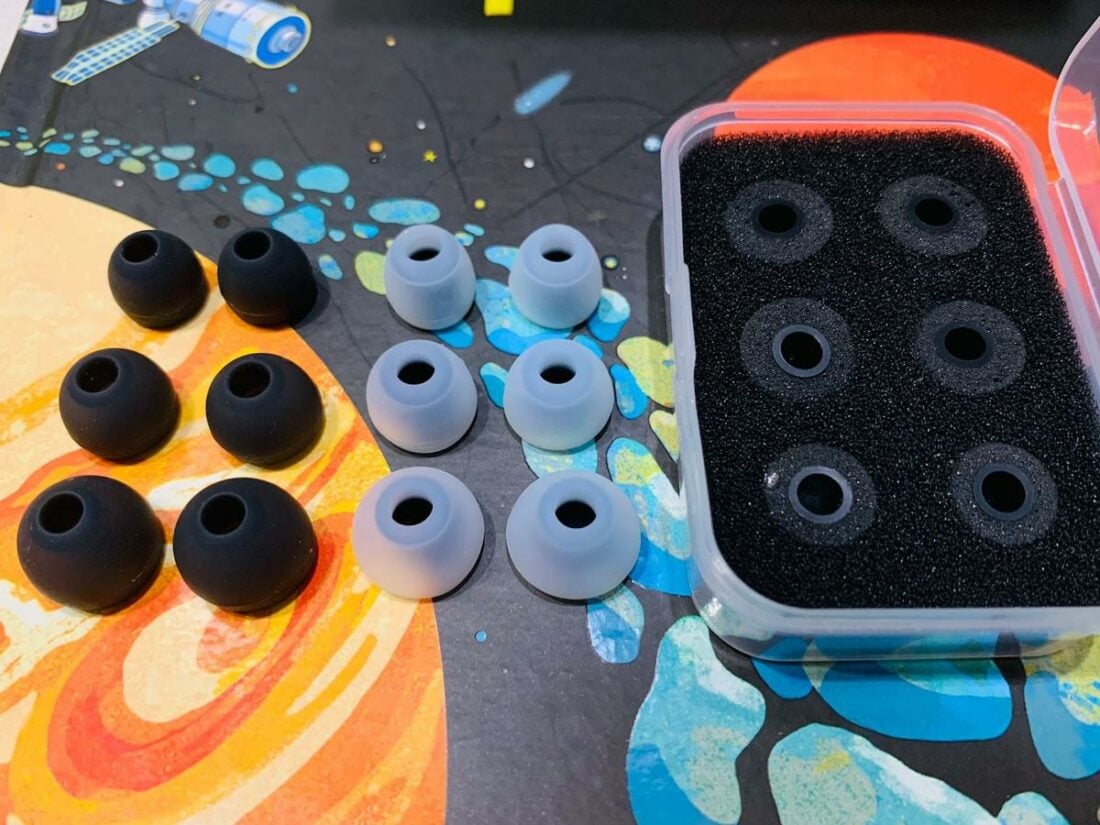
I really appreciate that LETSHUOER incorporated not two but three different types of ear tips in the packaging. The white silicone tips have a wider bore and boost the upper frequencies, in contrast to the black narrower-bore ones, which increase the low-end.
The included foam tips are useful to tame the treble and increase isolation, but, on the flip-side, they narrow the soundstage.
Cable
The provided cable is manufactured from silver-plated mono-crystalline copper, incorporating a 4 x 98-strand braid. The cable is pretty well-weaved, and is tangle-free with a chin cinch. Microphonics are unfortunately present.
This cable was not included with the original S12, and its selling point is the distal modular swappable plug, allowing one to swap 2.5mm, 3.5mm, and 4.4mm connectors.
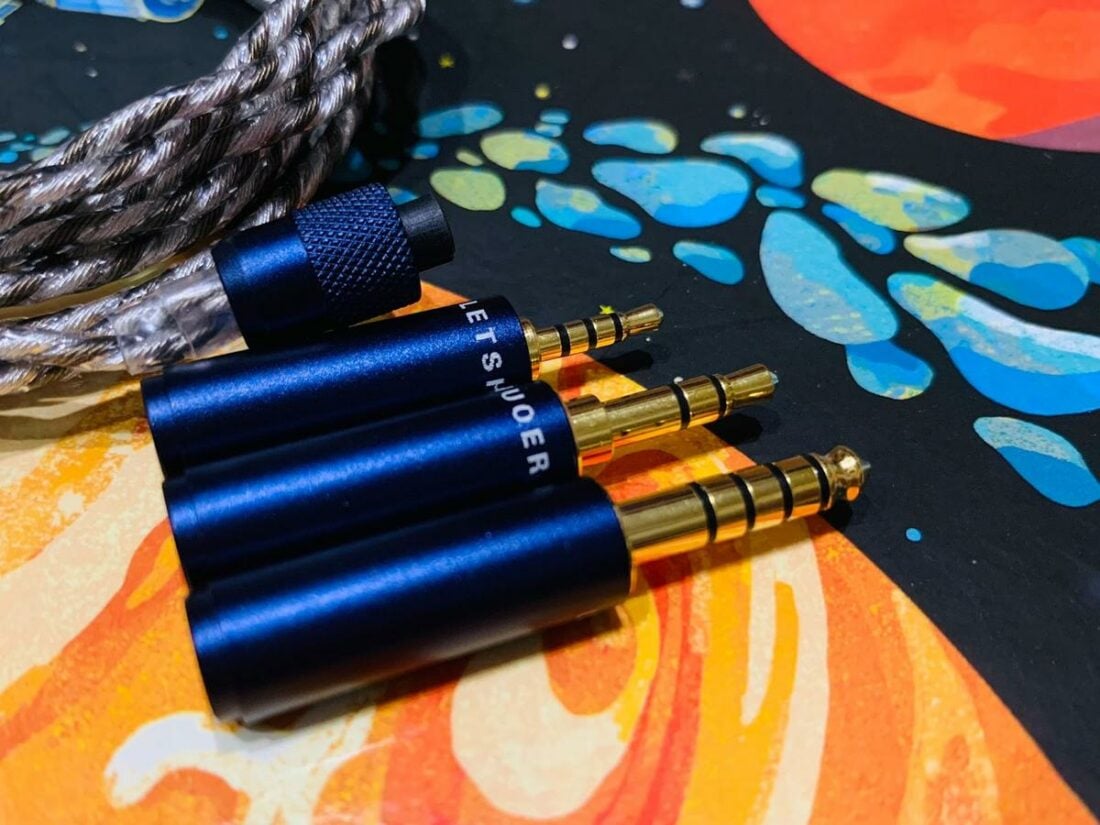
This swappable concept enables the S12 Pro to be paired with a myriad of balanced and single-ended sources. Also, this theoretically should decrease wear-and-tear for the 2-pin connector on the shells, as one does not need to keep unplugging and plugging the cable.
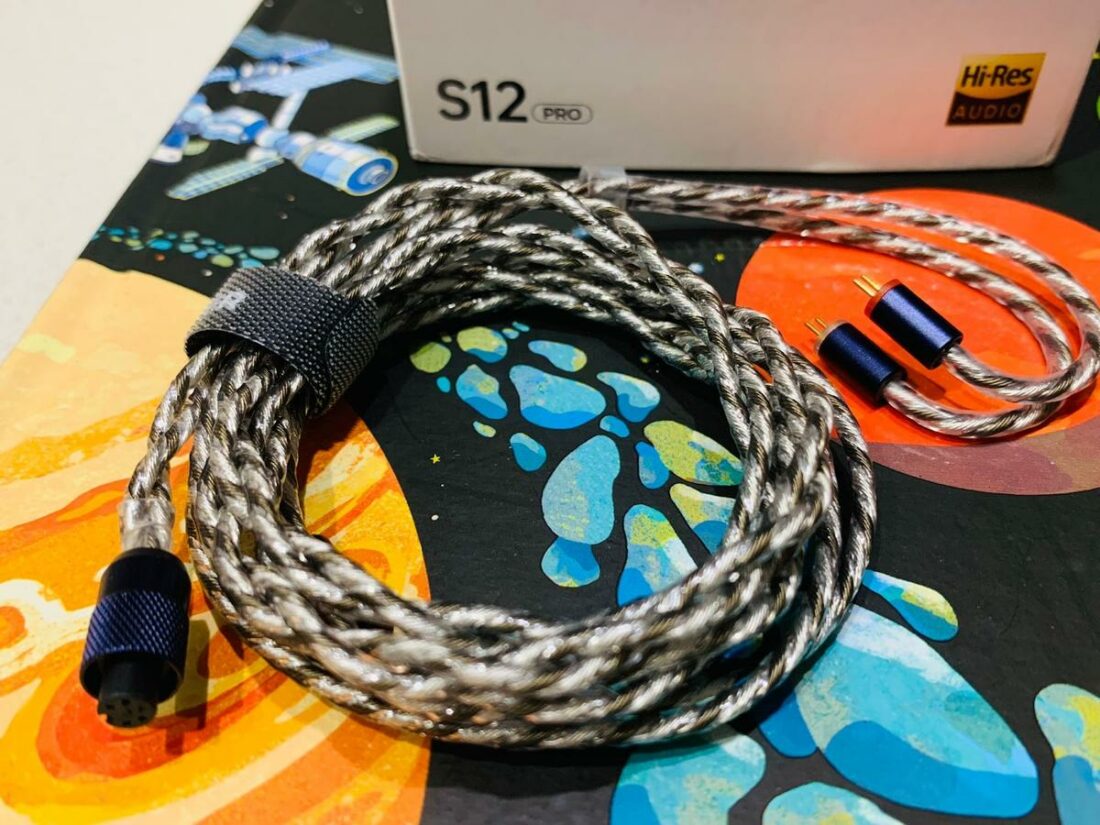
Sadly, there are no L and R markings on each end to identify the sides, but as per usual convention, the right terminal has a red marker.
Case
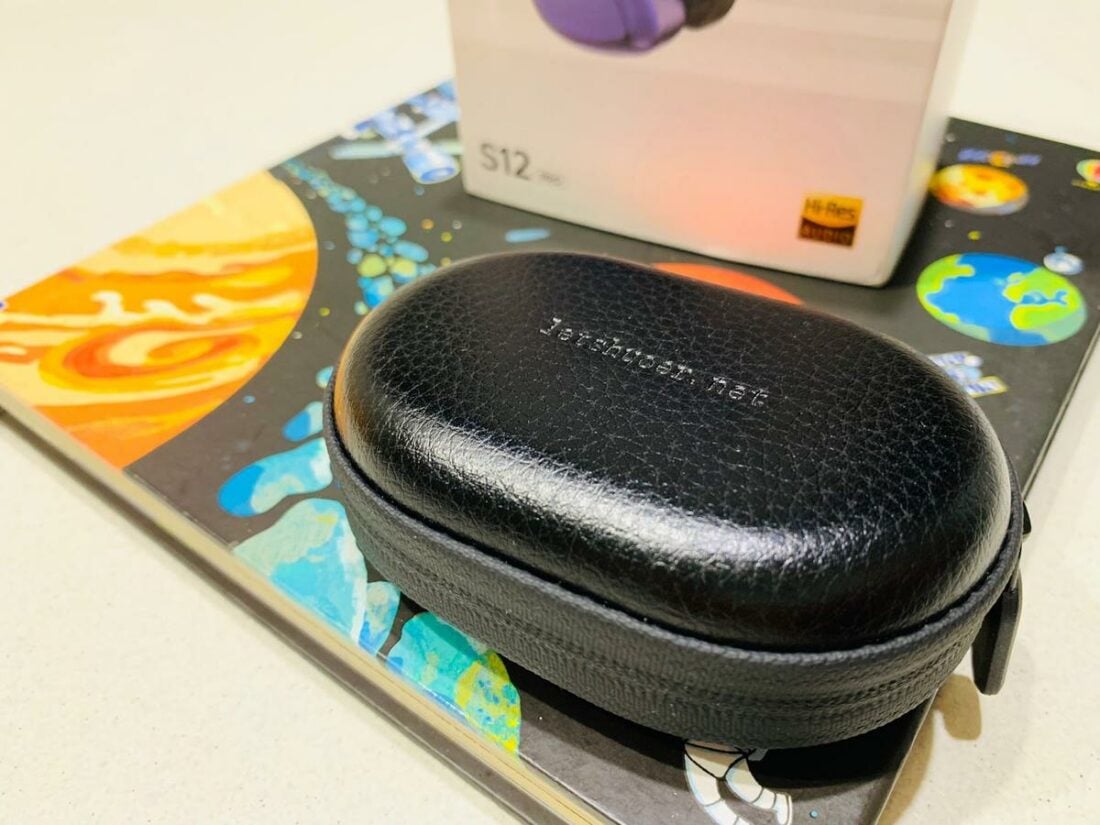
An oval leatherette case completes the accessories line-up. This case is very compact, with the inside having webbing to store accessories.
Design
While the shells of the S12 Pro look like the spitting image of the original S12, they come in an aerospace blue hue, which is a far cry from their predecessor’s dull gray color.
The aluminum housings are pretty minimalistic and feature a matte finish. Build quality is top-notch.
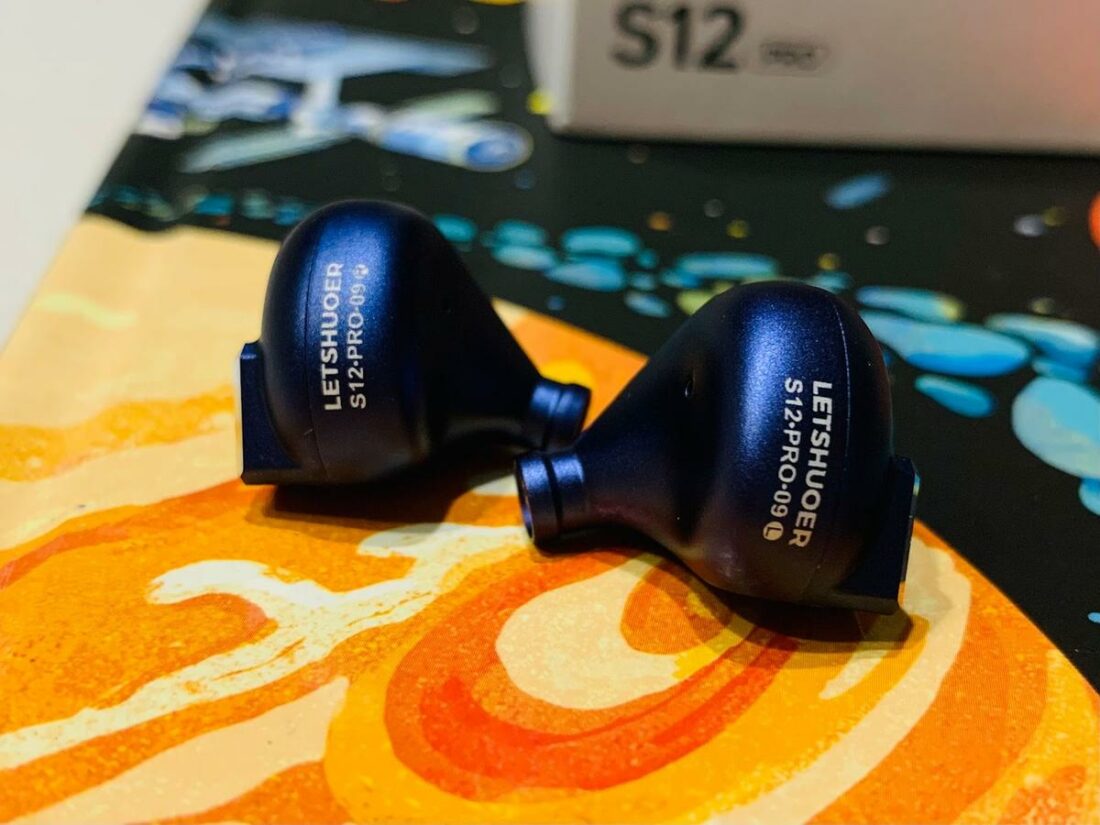
Despite the vents, isolation is actually above average, and these would make for a good commuting pair of IEMs.
Comfort
While there are no protruding or awkward edges, the S12 Pro’s nozzles are pretty short. Thus, those with bigger ears may encounter the shell pressing on the concha, leading to slight discomfort, especially when it comes to longer listening sessions. YMMV.
Internals
Well, I’m sure I need not emphasize that the S12 Pro utilize a custom 14.8mm planar magnetic driver.
LETSHUOER advertises that the innards of the S12 Pro are redesigned from their predecessor, featuring more vents to equalize pressure, with the addition of a rear acoustic chamber to provide better channel-matching.
LETSHUOER S12 Pro Sound
For a pair of planar IEMs, the S12 Pro are relatively easy to drive, but they scale with amplification. With more juice, tighter, extended bass and better dynamics are heard.
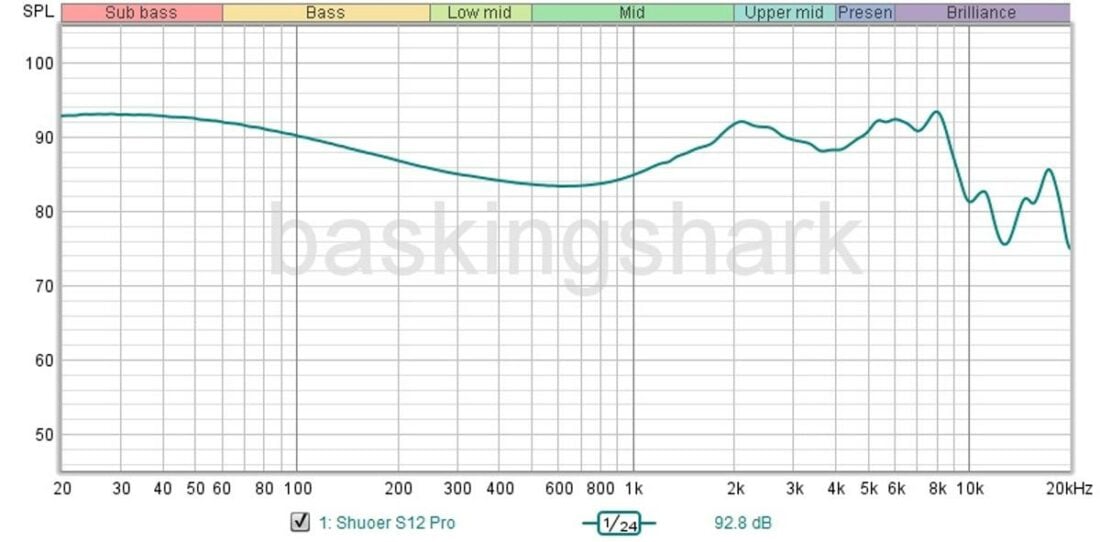
The S12 Pro are a fun-sounding, yet balanced, V-shaped pair of IEMs.
Bass
The S12 Pro’s low-end focuses on the mid-bass, with just moderate sub-bass extension. Bass is north of neutral but not at bonafide basshead levels.
IEMs with planar drivers handling the bass frequencies generally have rapid bass transients but do not move air or decay as much as traditional DD drivers, which is the case with the S12 Pro.
In terms of quality, bass texturing is pillowy and sometimes can sound undefined, but bass speed is lightning fast and can cope with complex bass movements. There’s just a hint of mid-bass bleed, but thankfully the bass does not encroach much into the midrange.
Midrange
As per the V-shaped tuning, the lower mids are recessed, so the S12 Pro may not be the best option for mid-lovers, especially for vocal- or acoustic-predominant tracks. The upper midrange is boosted but just at the edge of spiciness.
Treble
The S12 Pro are a bright pair of IEMs; make no bones about it. They have moderate treble extension, sparkle, and air, but for longer listening sessions, treble-sensitive folk might have an issue.
The brightness brings a lot of clarity to the table, though on the flip side, there is sibilance and some splashiness for high hats and cymbals. Thankfully the provided foam tips can tame the treble brilliance a bit, so give this a try if you are treble-sensitive.
In the area of technicalities, the S12 Pro have above-average imaging, instrument separation, and layering. Micro-details are decent enough but not class-leading. The soundstage is unfortunately bang average and sounds in-your-head.
Like most of their planar brethren, the S12 Pro do have a somewhat unnatural timbre for acoustic instruments (especially when compared to single DD transducers). This may be a consequence of the planar drivers’ very fast transients and rapid decay. Note weight is on the thinner side.
Comparisons
The S12 Pro will be compared against some other mid-FI planars. Single DD, hybrids, and pure BA IEMs were excluded from the comparison as the different transducer types have their own pros and cons.
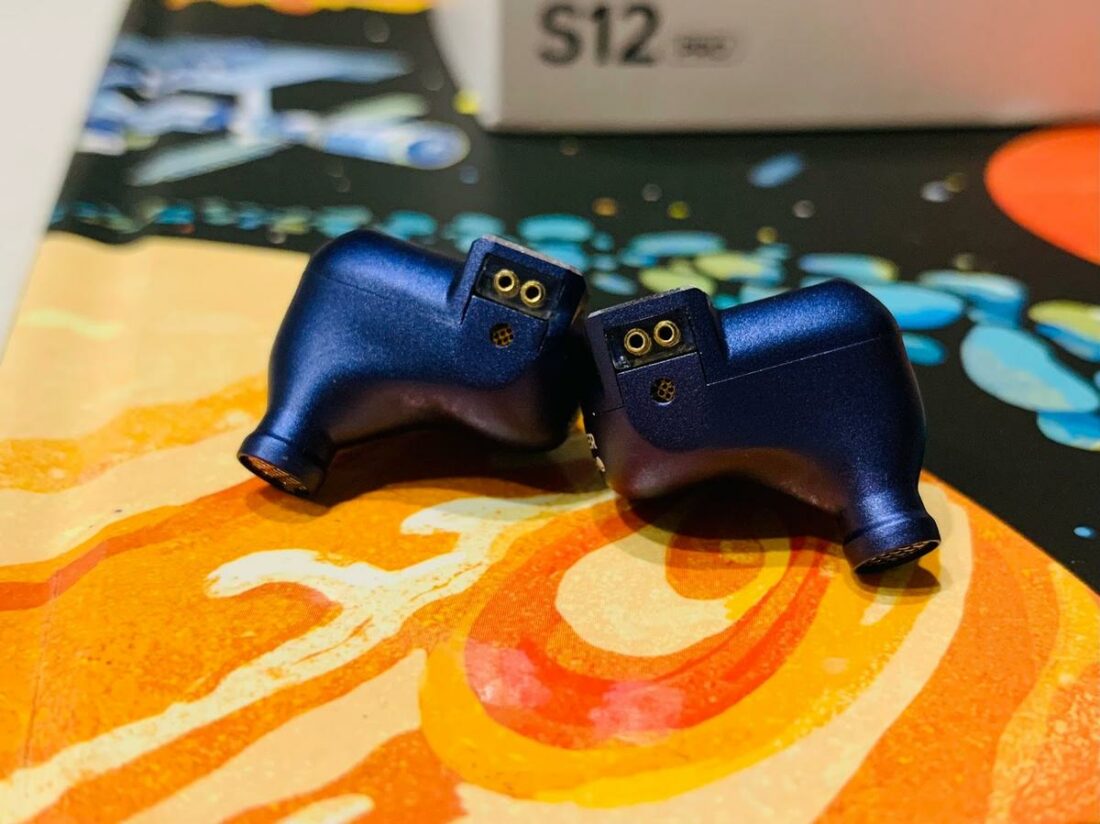
Vs. LETSHUOER S12
As discussed in the introduction above, the original S12 pro are marginally different from the original S12 in these areas:
- Different shell color
- An updated nozzle filter
- Swappable modular terminations for the cable
- Added vents on the housing to reduce ear pressure build-up/driver flex
In practice, the revamped nozzle filters don’t really change the tuning. The S12 siblings sound highly similar, and one would be splitting hairs to hear a significant difference in A/B testing (well, unless you have golden ears).
Hence, in terms of sonics, the S12 Pro are a chip off the old block, and I feel there is no impetus for existing owners of the original S12 to procure the Pro version.
Vs. 7Hz Timeless
The Timeless, as alluded to, were the spark plugs that drove the full force of the current planar hype down on our wallets.
The Timeless are less V-shaped than the S12 Pro, and the former are less bright, with not as deep sub-bass extension. Tonally, the Timeless are slightly warmer.
The Timeless have a tinge better resolution, imaging, and instrument separation but suffer from a pronounced lack of soundstage depth (though they have good soundstage width). In essence, music sounds very 2D with the Timeless. Coupled with a less natural timbre on the Timeless, these sound less organic than the S12 Pro.
Even though the S12 Pro are not the most comfortable pair, I actually had more fit issues with the Timeless. Considering that the Timeless are also more expensive, I would choose the S12 Pro between the two.
Vs Tangzu Audio Zetian Wu
The Zetian Wu are more L-shaped, with bigger sub-bass and less treble extension and quantity. The Zetian Wu come across as warmer and darker, with a thicker note weight. Tonally, the Zetian Wu are less sibilant and fatiguing, with a smoother treble.
The Zetian Wu are technically inferior, with fuzzier imaging, less micro-details, way-blunted edge definition, and worse instrument separation and micro-details. The Zetian Wu have a more marked mid-bass bleed with a less textured and slower bass.
However, timbral accuracy is more natural on the Zetian Wu, and the Zetian Wu have a lighter shell and are more comfortable.
Where to Buy
Conclusion
For consumers who want to board the planar hype train, the S12 Pro are arguably one of the better sets to consider. Boasting fast transients, above-average technicalities, a solid build, and a balanced V-shaped tuning, the S12 Pro do most departments well.
With the addition of a modular stock cable, the S12 Pro can also be paired with various unbalanced and balanced sources, adding a further feather in their cap.
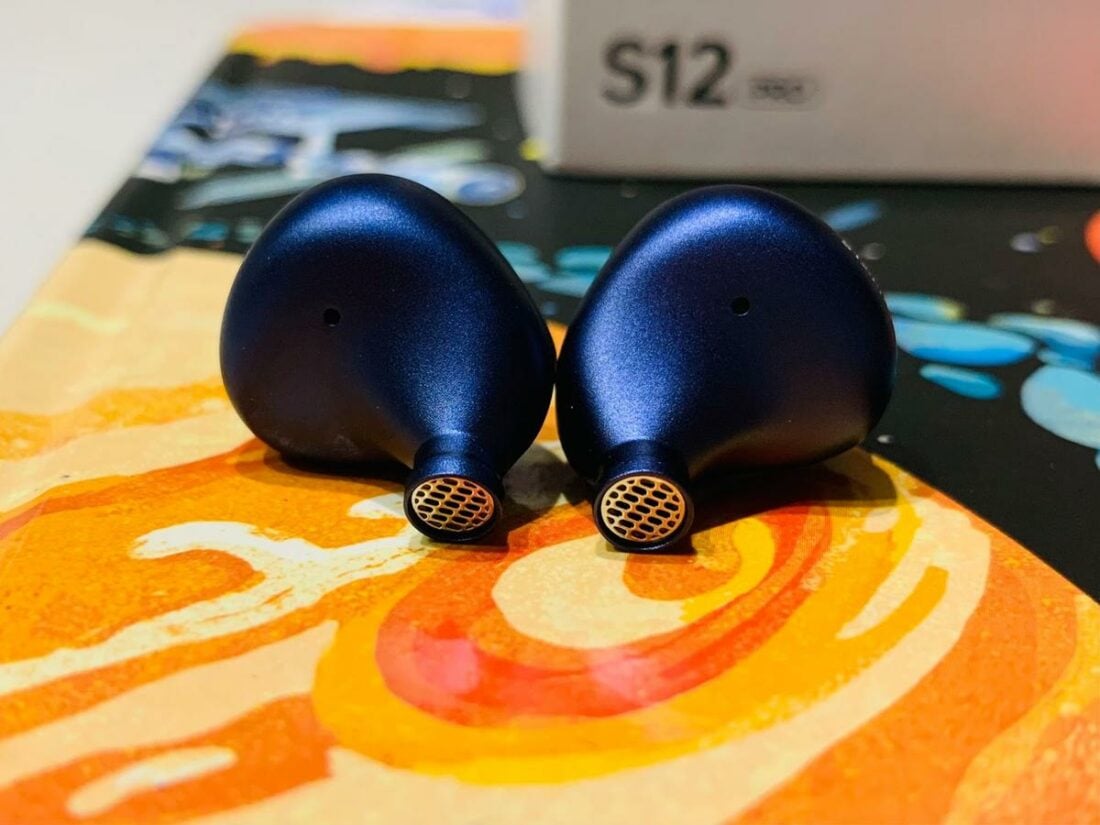
In terms of negatives, the S12 Pro may be a tinge bright for treble-sensitive folk, and vocal and midrange lovers might need to consider alternatives due to a depression in the lower mids.
Compared to their chief rival, the 7Hz Timeless may have slightly better resolution, but the S12 Pro have a more natural timbre, superior soundstage depth, and a better fit. Also, the S12 Pro are substantially cheaper, and I much prefer the S12 Pro.
To be honest, I’m a single DD guy and am not really a fan of planar timbre, but I appreciate the attributes the S12 Pro have, and these have a place in my collection. The S12 Pro will definitely be “gold-standard” planars that curious readers will ask to compare against when a new planar hype train comes along!
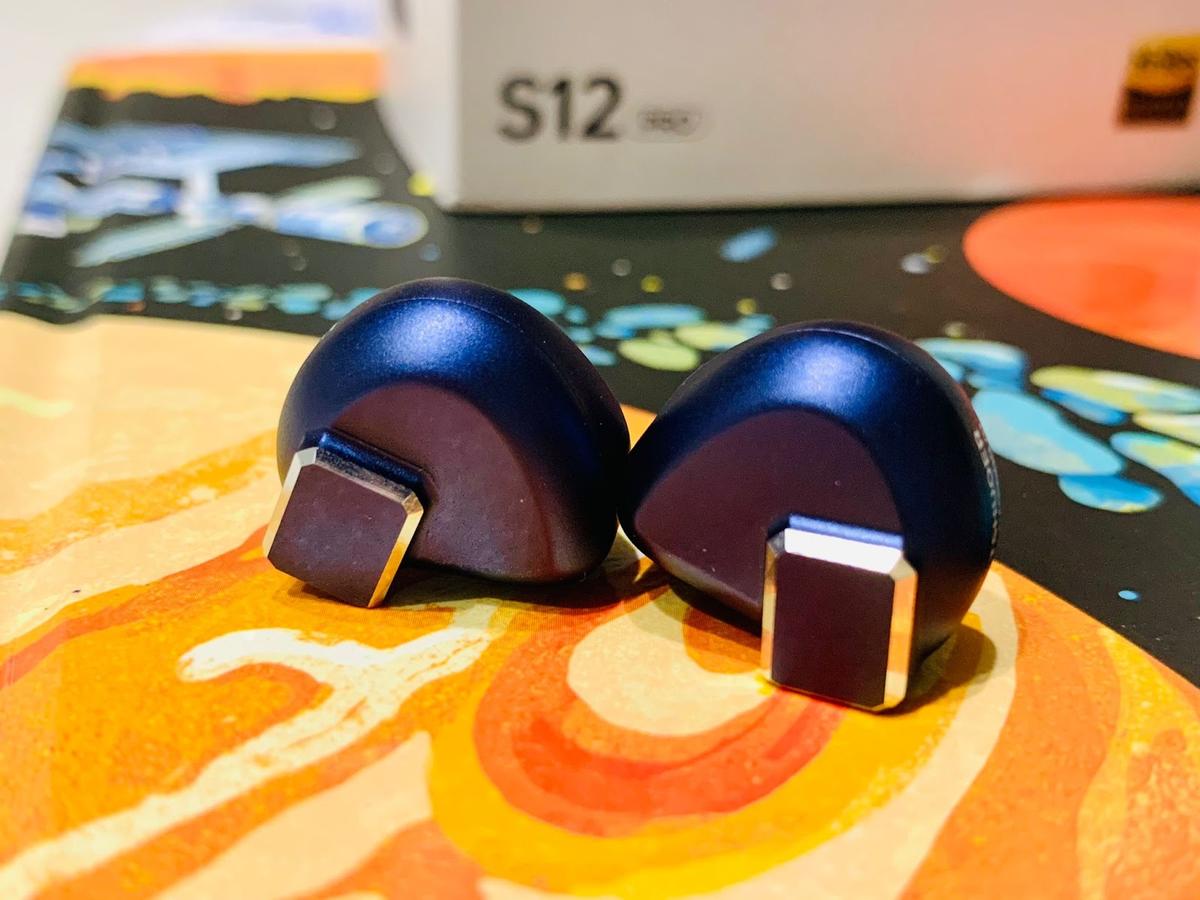
Coming from 7hz Salnotes Zero, would this be considered a significant upgrade?
Hi Sir
Yes, the S12 Pro is an upgrade over the Salnotes Zero in terms of technicalities.
However, the S12 Pro is a bit more V shaped, with bigger bass, and a more extended, sparkly treble. So tonally they are a bit different. The Salnotes Zero has a bit more natural timbre, in general, most single DDs (like the Zero) beat planars in timbral accuracy.
However, these are two different transducer (driver) types and they are competing at different price brackets, so a bit of an unfair comparison for the Salnotes Zero as such. A direct single DD upgrade from the Salnotes Zero would be something like the Dunu Titan S or Tripowin Olina.
Could you recomend me a better option than S12 pro?
I want a detail but fun iem with good sense of soundtage
Sub600€
Hi Sir
Yes the S12 Pro’s soundstage isn’t classleading.
Harman and Ebay are selling the AKG N5005 at $199 USD now, first hand.
https://www.harmanaudio.com/akg/AKGN5005BLK.html
It was a $1000 IEM a few years ago, but they are clearing the stock now. At $199 USD, this set is superb. It has 4 tuning options, from basshead to neutral to treblehead, and has excellent technicalities, holographic soundstage and superb details, great imaging and layering.
I bought one set and am very happy with it.
One thing, the fit may be a bit of an issue for those with smaller ears, and it also has BA timbre, but otherwise, I think at $199 USD, it is a great deal, can compete with most IEMs under $500 USD in technicalities. At $1000 full price, perhaps it is not the best option though.
Hi Sir
Yes the S12 Pro isn’t classleading in soundstage.
Perhaps you can read about the AKG N5005. It was released at $1K USD a few years back, but Harman is currently clearing stock and selling it at $199 USD on ebay and Harman:
https://www.harmanaudio.com/akg/AKG+N5005.html
https://www.ebay.com/itm/154910446024
It has 4 tuning options, so it can be converted from basshead to neutralish to treblehead. Very good imaging, soundstage, micro-details, holographic soundstage if amplified (needs amplification as it is quite hard to drive).
I bought one and am quite happy with it. I think it competes with most hybrids below $500 USD in technicalities, though perhaps at $1k USD it was a bit overpriced.
Cons: it has BA timbre, and fit may be a bit iffy for those with bigger ears.
Thank you! I already had my eye on him but from my country (Spain is impossible) Akg does not ship here. I also tried to buy it from a shop here but they couldn’t bring it…
Is the kato potentially better than the S12 pro?
Hi Sir
They are kind of apples to oranges comparison between a planar (S12 Pro) and a single DD (KATO). The 2 driver types have their own pros and cons.
FWIW, the KATO is more neutral than the V-shaped S12 Pro. S12 Pro has more bass and treble, but the S12 Pro’s bass isn’t as tight, and the treble can be harsher and more sibilant on the S12 Pro.
S12 Pro has better technicalities for sure, but a more artificial timbre than the KATO.
Thank you… I think that having the Ikko Oh10 is not worth buying the S12. From what you say I will like the S12 better than the kato.
I need almost an end game. Too bad the Akg is not sold here.
Do you have any eartips recommedations for the S12 pro?
Hi Sir/Mdm
Due to our different ear anatomies, what works for someone may not work for another, when it comes to eartips. They not only affect comfort, but isolation and also tonality of the IEM. Is there any aspect of isolation or sound that you would like to change with eartips on the S12 Pro?
FWIW, I do think the eartips supplied in the S12 Pro are quite adequate.
There are 3 types included. There’s a white wide bore silicone tip that boosts treble and increases soundstage, and a black narrow bore silicone one that increase bass, but decrease soundstage.
And lastly, there’s foam tips which tame the treble and increase isolation.
Personally, I like the black narrow bore ones, as the white tips made the treble a bit too much for my preferences.
Thanks for the reply, Sir.
I’ve tried all the silicone eartips and none fit me well. So I tried using my old spinfit CP145 and felt a noticeable improvement in comfort and I find it sounds better too. With the CP 145, It delivers better isolation and an overall nicer tone.
I’m looking for similar fit maybe another spinfit. I’m curious about the W1 because many said it Is a better version of CP145 and the spinfit pivoting tip help me to get a good seal in the S12 (hence the nozzles are relatively short). So what do you think about this? Or maybe you have another alternative?
Ah yes I just tried the CP 145 with the S12 Pro and it is a great match. The CP145 is quite neutral (doesn’t colour frequencies too much) and provides good fit and isolation, definitely a good pairing for this IEM, thanks for this good find.
I don’t have the W1 unfortunately. But I will see if can procure a set from somewhere!
Great review bro! Was thinking if I should get the S12 or spend more for the Seekreal Dawn (Planar + BA) setup, wondering if it worth the extra money
Hi Inferno!
I apologize, I haven’t tried the Seekreal Dawn, but I have tried the DUNU Talos, which has an added BA (it can be switched between pure planar mode and BA+planar mode).
So the added BA in the Talos gives superb treble extension and resolution, adds lots of air, but makes it very fatiguing (so not for treble sensitive folk). It is way more technical with the BA switch turned on, though most consumers can’t use it for too long sessions.
As for your query about getting the S12, what are your preferred music genres? And are you a treblehead, basshead etc?
I’m currently on a search for an IEM but there’s a lot of option I’m confused what to choose (im new) . I listen to a lot of j-pops and EDMs. Currently my consideration is galileo, dioko, hexa, s12 pro, aria or er2se? Any recommendations? Thanks in advance
Vs Tanchjim Oxygen from Tonality & Technical Performance?
Hi, in your review you mention schiit asgard 3 as one of the sources for driving the letshuoer s12 pro, how well do you think it scaled with a desktop?Do you think it can beat more expensive IEM such as moondrop variations and sennheiser ie600 in raw technical ability when paired with a asgard 3 in high gain?
How well did the s12 pro scale with power? Was the asgard 3 you mentioned in the review enough to elevate its technicalities above the timeless ?